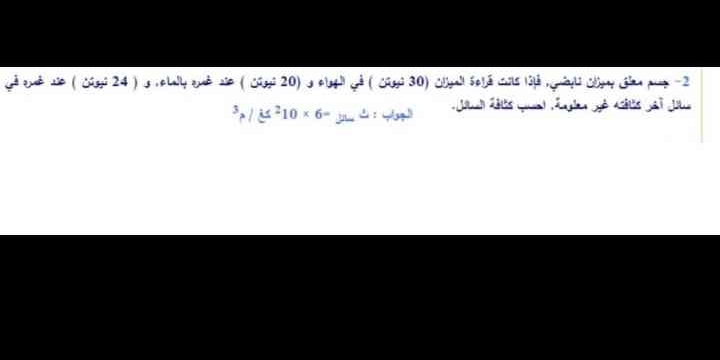جسم معلق بميزان نابضي، فإذا كانت قراءة الميزان (30 نيوتن) في الهواء و (20 نيوتن) عند غمره بالماء، و (24 نيوتن) عند غمره في سائل آخر كثافته غير معلومة. احسب كثافة السائل. جسم معلق بميزان نابضي، فإذا كانت قراءة الميزان (30 نيوتن) في الهواء و (20 نيوتن) عند غمره بالماء، و (24 نيوتن) عند غمره في سائل آخر كثافته غير معلومة. احسب كثافة السائل.

Understand the Problem
السؤال يطلب حساب كثافة سائل باستخدام قراءات ميزان نابضي لجسم معلق في الهواء، عند غمره في الماء، وعند غمره في السائل المجهول. يجب استخدام قراءات الميزان وقانون الطفو لتحديد كثافة السائل.
Answer
$600 kg/m^3$
Answer for screen readers
$600 kg/m^3$
Steps to Solve
- Calculate the buoyant force in water.
The buoyant force is the difference between the weight in air and the weight in water:
$F_{b,water} = W_{air} - W_{water} = 30 N - 20 N = 10 N$
- Calculate the buoyant force in the unknown liquid.
The buoyant force in the unknown liquid is the difference between the weight in air and the weight in the liquid:
$F_{b,liquid} = W_{air} - W_{liquid} = 30 N - 24 N = 6 N$
- Determine the volume of the object
The buoyant force in water is equal to the weight of the water displaced by the object i.e. $F_{b,water} = \rho_{water} V g $, where $ \rho_{water} $ is the density of water = $1000 kg/m^3$, $V$ is the volume of the object, and $g$ is the acceleration due to gravity. Thus, the volume can be found as: $V = \frac{F_{b,water}}{\rho_{water} g} $
-
The value of g is not given, so we can leave it as a variable or assume it is equal to 10 $V = \frac{10}{\rho_{water} g} = \frac{10}{1000 g} = \frac{0.01}{g} m^3 $
-
Determine the density of the unknown liquid
The buoyant force in the unknown liquid is equal to the weight of the liquid displaced by the object; hence $F_{b,liquid} = \rho_{liquid} V g $. Rearrange to solve for the density of the liquid:
$\rho_{liquid} = \frac{F_{b,liquid}}{Vg} $
- Plug in the values
$\rho_{liquid} = \frac{6}{(\frac{0.01}{g})g} = \frac{6}{0.01} = 600 kg/m^3 $
$600 kg/m^3$
More Information
The problem utilizes Archimedes' principle and the concept of buoyancy to determine the density of an unknown liquid.
Tips
- Forgetting to subtract the weight in the fluid from the weight in air to find the buoyant force.
- Using the wrong units.
- Incorrectly solving for the volume.
AI-generated content may contain errors. Please verify critical information